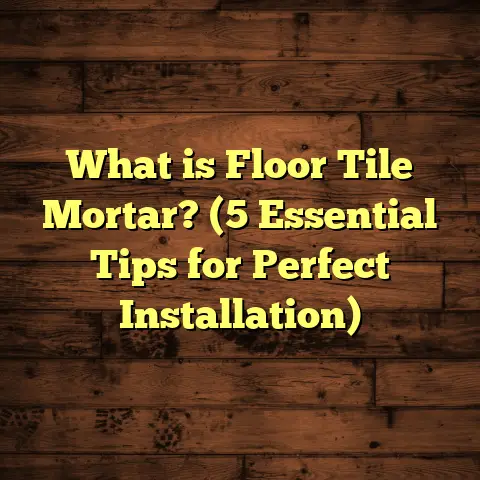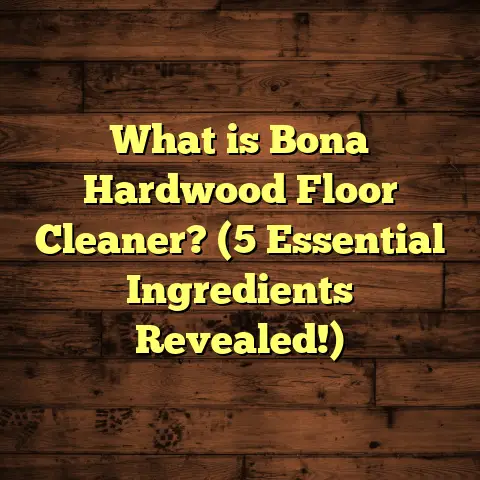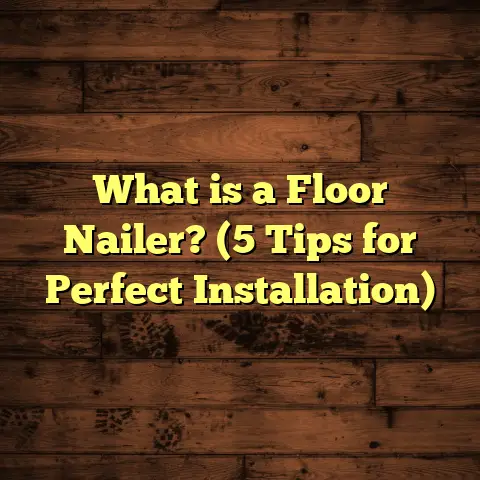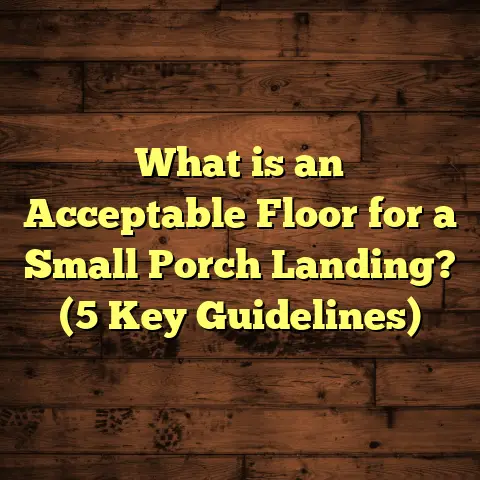What is the Floor of a House? (5 Key Types Explained)
What is the Floor of a House?
Have you ever stopped to think about the floor beneath your feet? I mean, really think about it—not just as the surface you walk on, but as a critical part of your home’s structure and style. When I first started working in flooring, I took floors for granted. I assumed all floors were pretty much the same: a surface to stand on. But as I got deeper into the trade, I discovered the vast complexity and importance of floors in homes.
So, what exactly is the floor of a house? At its core, the floor is the bottom surface within any room or living space that supports people, furniture, and everything else inside. But it’s made up of more than just that visible surface. Floors generally have several layers—a subfloor that gives structural strength, an underlayment that smooths out imperfections and sometimes adds moisture protection or soundproofing, and finally, the finish floor that you see and touch.
The subfloor is often plywood or oriented strand board (OSB), nailed or glued to the floor joists below. On top of that sits the underlayment, which can be foam, cork, or plywood sheets—depending on the type of finish floor being installed.
The finish floor is where things get creative and practical. It could be hardwood planks, vinyl tiles, carpet, ceramic tiles, or something else entirely. This layer is designed to look good, stand up to wear and tear, and sometimes even provide comfort underfoot.
Over the years, I’ve learned that choosing the right floor is more than picking a color or texture. It’s about understanding how floors behave under different conditions, how they affect your home’s vibe, and how long they last.
Why Floors Matter So Much
You might wonder why I put so much emphasis on floors. Here’s the thing: floors affect everything from energy efficiency to indoor air quality to your daily comfort.
For example, certain flooring materials like carpet can trap allergens and dust if not cleaned regularly. Hardwood floors are easier to clean but need protection against moisture and scratches. Tile floors can be slippery when wet but are excellent in terms of durability.
And let’s not forget about resale value. Floors are one of the first things potential buyers notice when they step into a home. A well-maintained hardwood floor can add thousands to your home’s value; poorly installed or damaged floors can turn buyers away.
Through my years in this business, I’ve seen floors make or break renovations and new builds alike. The right choice can enhance the beauty of your home and provide decades of satisfaction. The wrong choice leads to frustration, costly repairs, and frequent replacements.
The 5 Key Types of Flooring: My Experience and Insights
I want to walk you through five common types of flooring that I’ve worked with extensively. Each has its own set of advantages and challenges based on my hands-on experience with clients and projects.
1. Hardwood Flooring: Classic Beauty with a Few Hiccups
Hardwood flooring is probably the most iconic type of floor in residential homes. The natural grain patterns, warm colors, and ability to refinish hardwood floors repeatedly make them highly desirable.
What I’ve learned: Hardwood floors are made from solid wood planks, usually 3/4 inches thick, milled from trees like oak, maple, cherry, or walnut. When properly installed over a stable subfloor with adequate moisture control, hardwood floors can last generations.
I remember one job where I installed red oak hardwood in a client’s living room. They loved how it transformed their space from dull and cold into warm and inviting. Over five years later, they called me back to refinish it after their kids left some scratches during playtime. The ability to sand and refinish hardwood multiple times is a huge plus for longevity.
Challenges: Hardwood reacts to moisture and humidity changes by expanding or contracting. This can cause gaps between planks or cupping if moisture levels aren’t controlled properly. I’ve had to replace sections in basements where previous owners ignored waterproofing.
Installation requires precision—nails must be driven with care to avoid squeaks later on. And because hardwood is a premium material, cost can be steep; including installation, prices often range from $8 to $15 per square foot.
Data Insight: According to the National Wood Flooring Association (NWFA), hardwood floors can last 100 years or more with proper care. Homes with hardwood flooring tend to sell for 1-2% more than those without.
2. Vinyl Flooring: Affordable Durability with Style
Vinyl flooring has made huge strides over the past decade. It used to get a bad rap for looking cheap or plastic-y, but modern luxury vinyl planks (LVP) and tiles (LVT) now mimic wood, stone, or ceramic with impressive realism.
My experience: One family wanted a floor for their kitchen that could handle spills, pet messes, and heavy foot traffic but didn’t want to spend a fortune or deal with hardwood’s maintenance headaches. I suggested luxury vinyl plank flooring. We installed it quickly over an existing subfloor, and it looked great.
Benefits: Vinyl is waterproof or highly water-resistant depending on type, which makes it perfect for kitchens, bathrooms, laundry rooms—even basements. It’s softer underfoot than tile and less expensive than hardwood—installation costs typically range $2-$7 per square foot.
Challenges: While durable against moisture and scratches from everyday use, vinyl can dent from heavy furniture or sharp objects. Some lower-end vinyl products release VOCs (volatile organic compounds), affecting indoor air quality if ventilation is poor.
Interesting Fact: Industry reports show vinyl flooring sales have grown annually by 7% in recent years due to improved technology and design options.
3. Tile Flooring: Long-Lasting Waterproof Option
Tile flooring—ceramic or porcelain—is one of my go-to choices for bathrooms, mudrooms, and entryways. It’s hard-wearing and impervious to water when installed correctly.
Personal anecdote: Years ago, I installed porcelain tile in a client’s shower stall using large-format tiles combined with waterproof membrane systems underneath. The result was stunning—a sleek surface that was easy to clean and has held up perfectly for over eight years.
Advantages: Tiles come in countless styles—from glossy subway tiles to rustic stone looks—and offer excellent durability. Porcelain tiles are denser than ceramic ones and less porous, making them ideal for high-moisture areas.
Downsides: Tile installation is labor-intensive and requires a very level subfloor; otherwise grout lines may crack or tiles may loosen over time. Tiles can feel cold and hard—not everyone loves that underfoot sensation.
Stats: According to tile manufacturers’ associations, over 80% of bathrooms in new homes feature some form of tile flooring due to its water resistance.
4. Carpet Flooring: Softness with Maintenance Needs
Carpet has long been popular for bedrooms and living areas where comfort and warmth are priorities.
From my experience: Families with young children often appreciate carpet for its soundproofing benefits and soft surface that cushions falls. I recall installing plush carpet in a client’s nursery where they loved how cozy it felt compared to harder surfaces.
Pros: Carpet provides insulation against cold floors and reduces noise transmission between rooms—great in multistory homes. It comes in many colors and textures at affordable prices ($3-$7 per square foot).
Cons: Carpets trap dust mites and allergens if not vacuumed regularly—a hassle for allergy sufferers. Stains can be stubborn despite spot treatments. Also, in humid climates carpets may absorb moisture leading to mold growth underneath if not dried properly.
Data Point: Carpet market share has slightly declined recently due to concerns over allergens but remains strong in colder regions where insulation matters most.
5. Engineered Wood Flooring: The Best of Both Worlds?
Engineered wood flooring consists of multiple layers of wood glued together with a solid hardwood veneer on top.
Why I like it: Engineered wood offers much of the look and feel of hardwood but with added dimensional stability—meaning it handles moisture changes better. This makes it suitable for areas like basements or kitchens where solid hardwood might warp.
I installed engineered wood flooring in a client’s basement family room where humidity levels fluctuated seasonally. The floor stayed stable with no warping after two years—something that wouldn’t have been possible with solid hardwood.
Benefits: Engineered wood can be installed as floating floors without nails or glue, making installation faster and easier than traditional hardwood.
Limitations: The veneer layer is thinner than solid wood planks (usually 2-5 mm), so it can only be refinished once or twice before replacement is needed.
Price range: Expect $4-$10 per square foot depending on wood species and thickness.
How I Handle Flooring Challenges
Flooring projects rarely go 100% smooth—there are always surprises along the way. For example:
- Subfloor issues: Uneven subfloors are common in older homes. Before installing any finish floor, I always check levelness with laser tools and fix dips or bumps with leveling compounds.
- Moisture problems: Moisture under floors can cause warping or mold growth. I use moisture meters to test subfloors before installation and recommend vapor barriers in damp areas.
- Material defects: Occasionally flooring materials have manufacturing defects like warped planks or color inconsistencies; inspecting deliveries carefully saves headaches later.
- DIY mistakes: I’ve had clients attempt DIY installations that failed because they skipped acclimating wood planks or didn’t leave expansion gaps around edges—always follow manufacturer guidelines.
- Budget constraints: Sometimes clients want premium flooring but have tight budgets; I help find affordable alternatives that still look good and perform well.
Flooring by the Numbers: More Data That Matters
Here’s some data from industry sources you might find interesting:
- Hardwood flooring accounts for roughly 15% of residential flooring sales but generates over 30% of revenue due to high prices.
- Vinyl flooring sales increased by more than 7% annually over the past five years.
- Tile is used in about 80%+ of new home bathrooms.
- Carpet holds approximately 25% market share but is declining slowly.
- Engineered wood flooring sales grew by around 12% last year due to demand for affordable wood-look options.
According to FloorScore certification data (a standard for low VOC emissions), choosing certified flooring products improves indoor air quality significantly—something many homeowners overlook when selecting materials.
Tips From My Years as a Flooring Pro
If you’re thinking about new floors for your home (or helping clients), here are some tips I share often:
- Always test your subfloor before installation—no matter what type of floor you choose.
- Think about foot traffic patterns when picking materials: busy kitchens need harder surfaces than guest bedrooms.
- Don’t skip acclimating wood-based products to your home’s temperature/humidity before installation.
- Consider your lifestyle: pets? Kids? Allergies? These factors affect your best choice.
- Look beyond aesthetics—durability and maintenance play huge roles over time.
- Budget realistically—not just for material costs but also installation labor and potential fixes.
- Ask about warranties from manufacturers and installers.
- Maintain your floors regularly according to manufacturer recommendations; small upkeep prevents expensive repairs later.
A Final Word (Without Saying “In Conclusion”)
The floor under your feet carries more than weight—it supports your life’s moments every day. Whether you want warmth underfoot with carpet, timeless beauty with hardwood, waterproof convenience with vinyl or tile, or a mix like engineered wood—you’ve got options backed by years of experience and data.
I’ve walked thousands of square feet across different homes, seen what works long-term, what fails fast, and what surprises even experts like me. If you want guidance tailored specifically for your home’s conditions or style preferences—or if you want help budgeting accurately—I’m here anytime for questions.
Flooring isn’t just about covering space—it’s about making your house feel truly yours beneath every step you take.
If you’d like me to help you figure out costs or explore specific brands/materials further just say the word!





